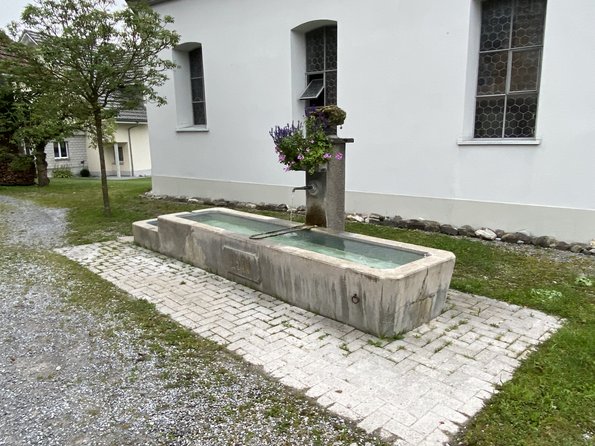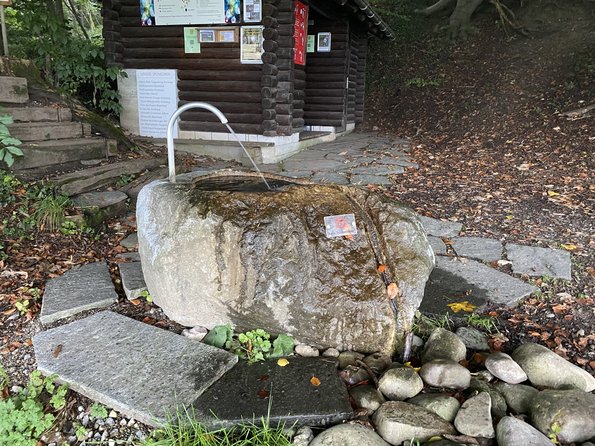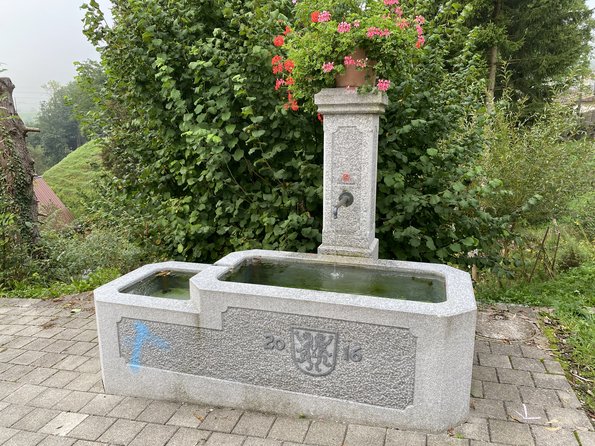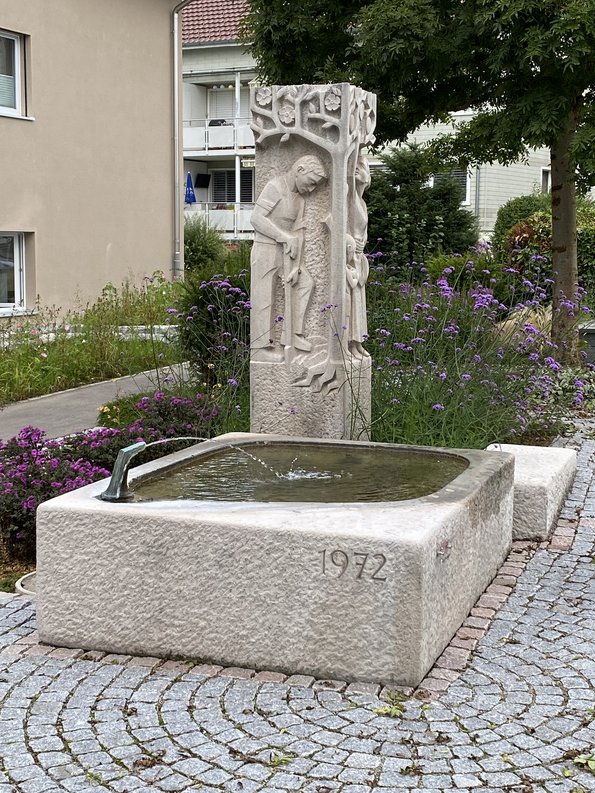Drinking water in Switzerland – from the village fountain and in emergencies
by Dr iur. Marianne Wüthrich
If you are a hiker or cyclist in Switzerland, you will find one or more fountains in every village where you can quench your thirst. Or rather until a few years ago, you could rely on the village fountains. In recent times, more and more fountains have a sign installed saying “No drinking water”. Because the water is not safe? Or because the water quality controls regulated by the Federation would be too costly for the municipal authorities and the farms? These questions demand an answer, especially urgent in an emergency. Inspired by reading Gotthard Frick’s “Total digitalisation – a collapse is only a question of time” (see this issue), another question arises: Do we need electricity so that water flows from the fountain and our drinking water is safe?
Moated castle Switzerland – a privilege to be treasured and cherished
Being able to drink water “from the tap” at any time is a great privilege. We only become aware of this when we have to buy bottled drinking water on holiday at the seaside, and even more urgently, when we see in documentaries women and children in faraway countries who have to carry their water – the cleanliness of which is often not assured – for kilometres. This reality in large parts of the world is pointed out on the homepage of the Technical Services of my residence Wil (Technische Betriebe Wil, TBW): “To be adequately supplied with safe drinking water is considered a privilege worldwide. This is because only just under half of the world’s population has satisfactory sanitary facilities. Moreover, the global demand for water is growing twice as fast as the population.” (https://www.tb-wil.ch/wasser)
Switzerland is a “moated castle”. This means that the numerous rivers, lakes and glaciers, the rain and the snowmelt in spring provide more than enough and usually also perfect water for the needs of the population – even if the summer sometimes is too dry. The Technical Services write: “Due to the nature of the soil, the water of Wil meets the high-quality requirements of the Food Law without human intervention. All water conveyed by the Technical Services reaches our customers unfiltered, untreated and unvaccinated from the pumping stations and spring tappings via the reservoirs”.
Strict legal requirements for Swiss fountain operators
So, everything is fine! If our ground- and spring water is clean enough for the tap in the kitchen, then it should actually also be drinkable from the village fountain. At least that is how it was fifty years ago when we children quenched our thirst at the fountain, and that is how it was throughout the country until a few years ago. In this sense, the Swiss Gas and Water Association (SVGW) states in 2018: “In Switzerland, it is assumed that the flowing water at publicly accessible fountains is drinkable unless there is an explicit drinking prohibition or warning sign. It does not matter whether the fountain is privately or publicly owned.”1 Such warnings used to be very rare. But today they are on more and more fountains all at once. Why?
There is one problem. According to the SVGW leaflet, “flowing fountains, i. e., fountains where the water flows permanently, are considered as ‘structures’ under Swiss law. This is where strict liability2 comes into play. If people are injured due to reduced water quality or other defects of a publicly accessible fountain, the owner of the fountain has to pay for the damage caused.”
However, the new legal requirements for Swiss well operators are not child’s play. The basis can be found in Article 3 of the Drinking Water Ordinance of the Federal Department of Home Affairs (FDHA)3, which has only been in force for a few years:
Art. 3 Requirements for drinking water
1 Drinking water must be inconspicuous in terms of odor, taste and appearance and must not pose a health hazard in terms of the type and concentration of microorganisms, parasites and contaminants it contains.
2 Drinking water must meet the minimum requirements specified in Annexes 1–3.
3 The operator of a drinking water supply system shall also [...] periodically carry out an analysis of the hazards to water resources.
The first paragraph of the article makes sense. However, the three annexes mentioned in paragraph 2 are quite a challenge: Annex 1 Microbiological requirements, Annex 2 Chemical requirements (maximum values of around 50! different chemical substances must be complied with), Annex 3 Further requirements for drinking water. Even without having the appropriate technical knowledge, the reader can guess that a full-time fountain inspector would be needed to meet the requirements.
In the small town of Wil, the tap water is checked every month: “To ensure that the water in Wil is clean, water samples are taken every month and analysed bacteriologically and chemically. The Cantonal Laboratory, as the enforcement authority, monitors compliance with quality requirements.” (https://www.tb-wil.ch/wasser) Upon request to the Technical Agencies Wil, I learned that the water of the Wiler fountains is also monitored in this process, because they are mostly directly connected to the drinking water network. However, this does not apply to many wells in the countryside.
The well drinking water is not worse than in the past …
The fountains on the village squares and also many others, which stand at the roadside and belong to farms or other private houses, obtain their water mostly directly from a spring. For example, the well in a hamlet of the municipality of Wuppenau, as my husband learned from the owner of the farm belonging to it. The well has no warning sign, so that we always refill our water bottle there when we ride our bikes. A few hundred meters away there is a well with the sign “No drinking water”.
I asked Hanspeter Gantenbein, the former long-time president of the commune Wuppenau, about the reasons for the increasing number of warning signs. He replied: “The fountain drinking water has not become worse compared to the past, but we require ever greater safeguards, since contamination could possibly occur at some point under certain circumstances. Our quality system now requires regular laboratory water testing, and then no one can be held liable.”
“... but the common sense is getting more and more lost”
The former commune president Gantenbein says: “The water from the wells you mentioned (and I could list at least another twenty wells in our municipality) comes from local sources for which there are no official, elaborate quality tests, so they cannot be called drinking water. The well operator has the alternative of simply turning off his well, making it inaccessible to strangers, having the well water tested regularly or connecting it to the municipality’s water pipes. The last two options are far too expensive, so to avoid juristic liability many attach the designation 'no drinking water’.”
His personal opinion, says Hanspeter Gantenbein: “The common sense is getting more and more lost – and in an incident of any kind, it’s only all about who you can blame!” The author of a newspaper commentary came to a similar conclusion while hiking through Switzerland in the late autumn of 2020: “I kept passing wells, but usually there was a sign: ‘No drinking water’. I was somewhat irritated. The rippling fountain stood in the middle of nature – and the water was not supposed to be drinkable?” Finally, the hiker came across a well with the inscription: “Spring water, but no drinking water due to legal regulations. Enjoy at your own risk.” He was excited about this information and tasted the water, which was excellent. He realised that the sign “No drinking water” is mainly put up for legal reasons: “The warning has not much to do with the quality of the water.”4
Drinking water supply in shortage situations – the water could quickly become scarce!
These assessments by two practical-minded people are important in case the water pipes do not work one day, which we cannot exclude in Switzerland either. Recently, a brochure from the cantonal “Office of Military and Civil Defence” was in all mailboxes in the canton of St. Gallen, presenting the canton’s precautions in the event of an evacuation or a prolonged power blackout, with checklists of the necessary precautions for the population. The brochure is supplemented with a leaflet “Emergency luggage for an evacuation” and a leaflet “Emergency supplies at home (for at least 5 days)”. One of the most important items is a mineral water supply of at least 10 litres per person. It is good that we are reminded once again to refresh the provisions for our families – if necessary.
Because the drinking water from our taps would quickly stop flowing in the event of a longer power cut. In response to my question: “How is the water supply secured in emergency situations if the electricity were to fail for a longer period of time?” I received an unexpectedly shocking answer from Andreas Gnos, Head of Network and Technology at the Technical Works Wil (TBW): “If the electricity fails, then the water supply network is no longer fed. Only the water from the reservoirs is still available, about one day’s consumption in Wil. From then on, cistern wagons have to be made available so that the population can collect water from certain places.”
Water for one day only! We would have to learn to limit ourselves unaccustomedly. According to the Federal Council’s “Ordinance on Drinking Water Supply in Severe Shortages (VTM)” of 19 August 2020 the Cantons are responsible for “securing the drinking water supply in situations of severe shortage” (Art. 3 para. 1). The prescribed minimum quantity for private households is only just “at least four litres per person per day” (Art. 2). By way of comparison: In 2019, every Swiss person consumed an average of about 294 litres of drinking water per day!5 There is nothing in the new ordinance about the obligation of residents to keep a water supply themselves, but Andreas Gnos says: “Personal responsibility applies in this area.”
Back to the wells: If the water pipes do not work, the population is fortunately left – besides self-sufficiency and cantonal rations – with the running wells, which are fed from springs and thus do not need electricity (or internet). We can assume that they will provide us with good drinking water. •
1 Swiss Gas and Water Association (Schweizerischer Verein des Gas- und Wasserfaches, SVGW). Leaflet for fountains W10031 from March 2018
2 Strict liability: According to Art. 58 of the Swiss Code of Obligations, “the owner of a building or any other structure is liable for any damage caused by defects in its construction or design or by inadequate maintenance”, even if he is not personally at fault.
3 817.022.11 Ordinance of the FDHA on Drinking Water and Water in Publicly Accessible Baths and Shower Facilities (TBDV) of 16 December 2016 (as of 1 August 2021).
4 Niederer, Alan. “’Kein Trinkwasser’ steht am Brunnen – soll ich das Wasser trotzdem kosten?” (‘No drinking water’ is written on the well – should I taste the water anyway?) In: Neue Zürcher Zeitung of 16 November 2020
5 https://de.statista.com/statistik/daten/studie/950548/umfrage/durchschnittlicher-trinkwasserverbrauch-in-der-schweiz-je-einwohner-und-tag/
Village fountains in Bazenheid (SG). Today, most of the fountains say “No drinking water”. (pictures ef/km)



